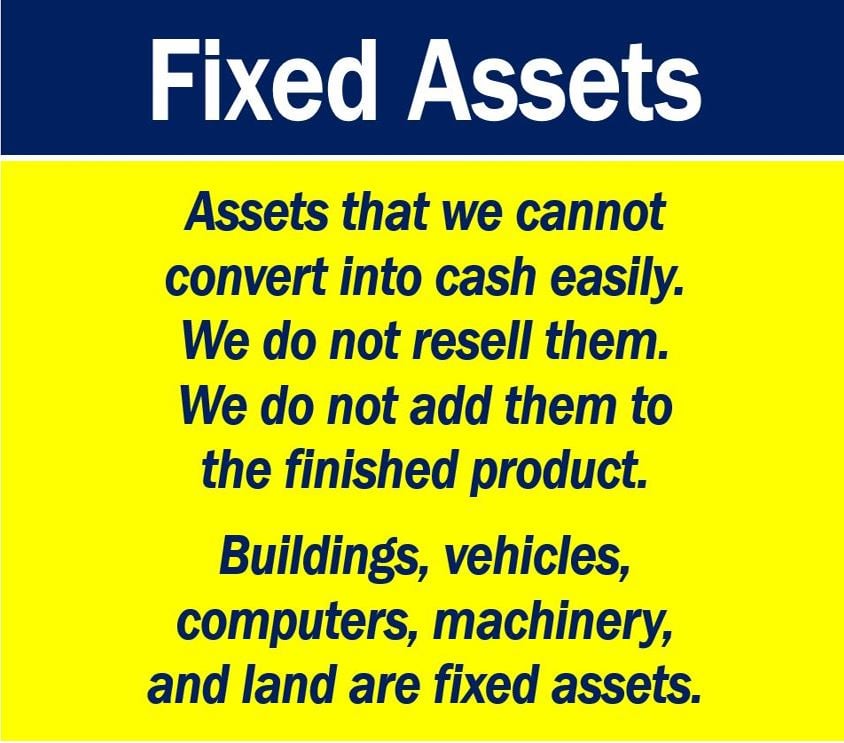Fixed Assets are tangible assets that cannot be easily converted into cash. Examples include property, plant, and equipment (PP&E). We do not resell fixed assets as part of a company’s everyday business operations.
Understanding the characteristics and management of fixed assets is crucial for effective financial planning and resource allocation in businesses.
Fixed assets are tangible pieces of property that a company uses in the production of its income or administrative purposes.
We use fixed capital to buy fixed assets. However, many people use the two terms interchangeably.
In manufacturing businesses, we sometimes refer to them collectively as ‘plant.’ Tangible assets are those we can touch.
Fixed assets vs. current assets
The term contrasts with current assets, i.e., liquid assets. Current assets are things a business owns that it can convert into cash easily, i.e., within twelve months.
A fixed asset does not necessarily have to be ‘fixed’ in the sense of being impossible to move. A computer is a fixed asset which we can move. We can move a vehicle, which is also a fixed asset.

Fixed assets are the things a business owns that help it produce and earn money. The company does not resell them as part of everyday business activities.
Accounting Tools has the following definition of fixed assets:
“A fixed asset is property with a useful life greater than one reporting period, and which exceeds an entity’s minimum capitalization limit. A fixed asset is not purchased with the intent of immediate resale, but rather for productive use within the entity. Also, it is not expected to be fully consumed within one year of its purchase.”
Fixed assets – tangible assets
In the vast majority of cases, we only class tangible assets as fixed. However, we categorize some long-term intangible assets as fixed intangible assets. Patents and trademarks, for example, belong to this category.
Accountants define a fixed asset as an item whose useful life is longer than one reporting period. They also define it as something which exceeds a company’s minimum capitalization limit.
We do not class an inventory item as a fixed asset. This is because the buyer plans on either reselling it or using it to make something else.
Fixed assets – examples
- vehicles,
- buildings,
- furniture and fixtures,
- leasehold improvements,
- machinery,
- land,
- computer equipment, and
- computer software.
According to accountingtools.com, we initially record a fixed asset as an asset. It is then subject to the following general kinds of accounting transactions:
- Periodic Depreciation (tangible assets), or Amortization (intangible assets,
- Impairment Write-downs (if the asset’s value falls below its net book value),
- Disposition (as soon as we dispose of an asset).
Two researchers at Pennsylvania State University found that fixed asset investors like sole dictatorships. They can make special deals with dictators, which make up for the risk. This preference for fixed assets in dictatorships often stems from their long-term stability and potential for higher returns, despite the associated political risks.
Example Sentences
Here are some sentences featuring the term “fixed assets” to illustrate its use in various contexts:
- “When preparing the balance sheet, the company’s building was listed as a fixed asset due to its long-term usefulness and value.”
- “The new printing press, a significant fixed asset, has greatly increased our production capacity.”
- “Our accountant emphasized the importance of accurately calculating depreciation for each fixed asset to reflect their diminishing value over time.”
- “During the meeting, the CFO clarified that investments in fixed assets would be prioritized to support long-term growth.”
- “The audit revealed that the company had not fully assessed the condition and value of its fixed assets.”
- “As part of our sustainability initiative, we are evaluating the energy efficiency of all our fixed assets.”
- “The acquisition of new machinery, a major fixed asset, requires careful consideration of its impact on our financial statements.”
Video – What are Fixed Assets?
This video presentation, from our sister channel on YouTube – Marketing Business Network, explains what the meaning of ‘Fixed Assets’ is using simple and easy-to-understand language and examples.
